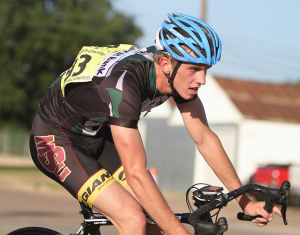Cycling team to participate in Hotter N’ Hell race Aug. 29
August 14, 2015

A full weekend of events, the Hotter N’ Hell Hundred is known for its community-orientation and competitive edge. It will begin Aug. 29 and attract competitors from around the globe, including the university’s own cycling team.
Charlie Zamastil, director of the university cycling team, left his home in Philadelphia to take the job three years ago. He said the team is the reason the university is a “big name” along the east coast.
“We’ve got a great program here, it’s respected around the country,” Zamastil said.
Today he coaches roughly 25 students, five of whom are female, who come from all over: New Zealand, South Africa, Honduras, Mexico and Sweden in addition to the United States, all of whom are training for the September track nationals in Colorado Springs.
“It’s pretty rigorous, most of them are self-motivated,” Zamastil said.
The team will also participate in the 34th Hotter’N Hell Hundred even though it lies outside of their training.
“[Their training is] very high intensity, which is not necessarily germane to doing a 100-mile road race. Expect us to do especially well in the criterions, the short racing that I want them to focus on,” he said.
Because his students are on different ability levels, Zamastil only puts them together to work about once a week. Otherwise he meets with them individually.
“Anything they try to do, they’re going to do it well,” he said. “I think it’s just fun when they come together and really deliver a solid team performance.”
Zamastil said people undervalue the value of teamwork in cycling sports, especially when it comes to goal-setting. Creating a plan is often difficult because of variables, but setting and accomplishing team goals is rewarding.
“Collectively we’re a lot stronger than when we’re all pursuing individual goals,” he said.
Of course, there is a lot more to the HHH than intense competition. Endurance rides, which are open to all who enjoy even casual cycling, host participants of all ages and bring the sense of community to its peak.
“It’s a moving party,” Sandy Fleming, off-road events director, said. “At no point are you by yourself. You get to meet people [from] all over the country. It’s like running in a great, big marathon. The whole thing is electric.”
Fleming joined the HHH team in 1988 and has either raced or directed ever since.
To answer one of the most-asked questions at the event, Fleming said that the volunteers now wear buttons that say, “We don’t RIDE the Hotter N’ Hell, we RUN the Hotter N’ Hell!”
“We give up our opportunity to have a fun athletic event that day just so everybody else can, and it’s so rewarding and we love to do that,” she said.
Ben Filer, a HHH coordinator, has worked rest stops since moving to town in 1988.
“In Wichita Falls, the reason that the ride is a success is we have over 4000 in the people in the community who volunteer and support it,” Filer said. “It is a community event.”
Community participation is essential to HHH. Aside from local non-profits providing volunteers, community members line up to cheer on the contestants and even ride along with their children in tow. Fleming, mother of two, spoke of the latter with animation.
“A lot of people raise their children out on the Hotter ‘N Hell Hundred – I know that’s what I’ve done with mine,” Fleming said. “One has either been in a trailer, in a tandem or on a bike every single year. They haven’t missed one since they were born.”
Off the track, Filer mentioned that the participants will have a chance to congregate over the traditional Friday-night spaghetti dinner, too.
“People can sit down and eat with 4,000 of their best friends,” he said.
Fleming and Filer agreed that community, not scenery or status, is the real lure for people to participate in HHH.
“We want to call that Wichita Falls-friendly, or Texas-friendly, because traveling around the country you encounter grumpy people, and there are really hardly any grumpy people in Wichita Falls,” Fleming said.
All proceeds will be donated to MSU, Children of Miracle Network, the local fire departments, and other non-profits who send volunteers.





